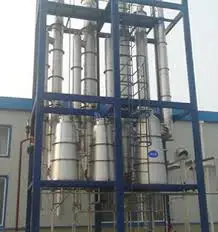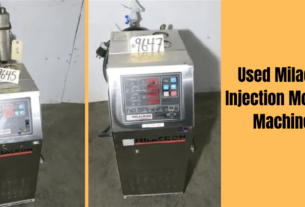Falling film evaporators are specialized types of evaporators commonly used in industries requiring efficient heat transfer for concentrating solutions, especially where delicate temperature control and minimal thermal degradation are critical. Their design allows for optimal heat transfer efficiency, making them a preferred choice in several industrial applications.
I. Definition of Falling Film Evaporators
A falling film evaporator is a type of evaporator that uses a thin film of liquid flowing down the inner surface of a heated tube, facilitating heat exchange and promoting the evaporation of the liquid. This setup makes them suitable for low-viscosity liquids and sensitive products. Due to the gentle heating, falling film evaporators are ideal for materials that require precise temperature control, such as food and pharmaceutical products. In industries where heat-sensitive materials need to be concentrated without compromising their quality, these evaporators are highly effective.
II. How Falling Film Evaporators Work
Falling film evaporators operate by allowing the liquid feed to enter at the top of a heated tube bundle. The liquid flows down the inner walls of these tubes in a thin film, created by gravity rather than through forced pumping. As the liquid film travels downwards, the heat applied on the outside of the tubes causes evaporation of the solvent, usually water, within the liquid film. This film ensures a large surface area for heat transfer, facilitating efficient vaporization.
The evaporated solvent vapor and the remaining concentrated liquid exit the tube bundle and are subsequently separated. The vapor then flows to a condenser, while the concentrated liquid product is collected. This method results in highly effective and rapid evaporation with minimal thermal stress on the liquid, making it particularly suitable for thermally sensitive products.
III. Advantages of Falling Film Evaporators
- High Heat Transfer Efficiency: Due to the thin film, these evaporators facilitate efficient heat exchange, allowing for rapid evaporation and shorter residence times.
- Minimal Thermal Degradation: Since heat is applied indirectly and the liquid flows quickly through the tubes, there’s minimal time for the product to be exposed to high temperatures. This characteristic preserves the quality of temperature-sensitive products.
- Low Energy Consumption: Falling film evaporators require less energy for operation, especially compared to traditional evaporators. They leverage gravity to assist in fluid movement, thereby reducing the need for energy-intensive pumps.
- Scalability: These systems are highly scalable and can be used across various industries and processes, from small batches to large-scale operations.
- Flexibility: Falling film evaporators work well with a range of liquid viscosities and are less prone to fouling compared to other evaporator types, reducing maintenance needs.
IV. Applications of Falling Film Evaporators
The versatile design and efficient performance make falling film evaporators ideal for various applications across industries:
- Food and Beverage Industry: These evaporators concentrate juices, dairy products, and other liquid foods. Due to their low thermal impact, they help preserve flavor, nutrients, and color.
- Pharmaceuticals: Used to concentrate active ingredients, these evaporators ensure that delicate compounds are preserved without degradation due to heat exposure.
- Chemical Processing: Falling film evaporators are also used to concentrate or purify chemicals in industries requiring stable thermal processes.
- Wastewater Treatment: They’re employed to evaporate water from waste, concentrating contaminants and reducing the volume of waste for disposal.
- Desalination: These systems play a role in desalination by concentrating brine solutions, allowing for more efficient salt recovery or disposal.
V. Design and Operation of Falling Film Evaporators
The Design and Operation of Falling Film Evaporators consists of a series of vertical tubes enclosed within a shell. The tubes serve as the primary site for heat transfer, as the liquid film moves down due to gravity. The liquid distribution system at the top of the tubes is crucial for ensuring that the feed is evenly spread across the inner tube surfaces, which guarantees consistent evaporation rates and uniform heat transfer.
During operation, the primary factors affecting performance are:
- Feed Rate and Film Thickness: An optimal feed rate is essential for maintaining a stable, uniform film thickness. Too thin a film may result in dry spots and fouling, while too thick a film reduces heat transfer efficiency.
- Heat Source and Temperature Control: Falling film evaporators are generally powered by steam or other heating media. Proper temperature control ensures efficient evaporation without thermal degradation.
- Vacuum Application: In some applications, applying a vacuum helps lower the boiling point of the liquid, which minimizes thermal degradation and saves energy. This is especially beneficial in industries where heat-sensitive materials are concentrated.
- Tube Design: The length, diameter, and material of the tubes impact the efficiency of the evaporator. Stainless steel is commonly used for its thermal conductivity and corrosion resistance, although other materials may be selected based on the specific process requirements.
In summary, falling film evaporators are highly efficient systems for achieving rapid and controlled evaporation with minimal thermal impact on the product. Their design, which uses a combination of gravity and heat transfer, makes them ideal for concentrating temperature-sensitive and low-viscosity liquids across diverse industrial applications. By understanding their operational mechanics and advantages, industries can leverage falling film evaporators to achieve enhanced processing efficiency, cost savings, and product quality.
Also read: The Inspirational Eugenio Pallisco Michigan Success Story




